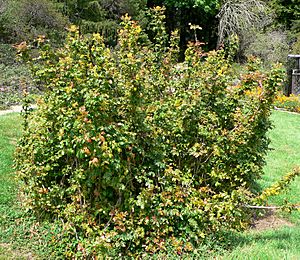California barberry facts for kids
Quick facts for kids California barberry |
|
|---|---|
 |
|
| Scientific classification | |
| Genus: |
Mahonia
|
| Species: |
pinnata
|
The Mahonia pinnata is a type of shrub that belongs to the barberry family. You might hear it called by other names like California barberry or wavyleaf barberry. It looks a lot like the Oregon-grape plant, so some people even call it the California Oregon-grape.
This plant grows naturally along the west coast of North America. You can find it from British Columbia all the way down to Baja California. It likes to live in forests, woodlands, and areas with chaparral plants.
Contents
Discovering the California Barberry
The Mahonia pinnata is a dark green bush. Its leaves look a bit like holly because they have jagged edges. In spring, this plant grows small, bright yellow flowers. These flowers often appear in clusters that are about one to two inches long.
After the flowers, the plant produces purple berries. These berries are safe to eat, but they taste quite sour! Each berry also has many tiny seeds inside.
How People and Animals Use It
The berries of the Mahonia pinnata aren't just for eating. People have used them to make a beautiful purple dye for a long time.
This shrub is also popular for landscaping. People plant it in their gardens because it looks nice. It's known as an ornamental plant.
Many songbirds also love the berries from this plant. They are a good food source for them!
Protecting This Special Plant
Sadly, one type of Mahonia pinnata is very rare. It is listed as an endangered species by the government. This means it is in danger of disappearing forever.
This rare type is only found on Santa Cruz Island. This island is one of the Channel Islands off the coast of California. There are only about 13 or fewer of these special plants left in the wild.
Where Did the Name Come From?
The name Mahonia comes from a person! It was named after Bernard McMahon, who was an American gardener and plant expert. He lived from 1775 to 1816.
The second part of the name, Pinnata, is a Latin word. It means 'set in two opposite rows'. This describes how the small leaves (called leaflets) are arranged on the plant's stems.

